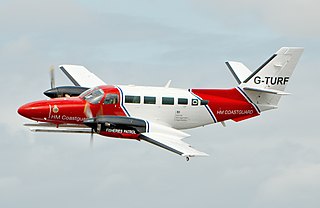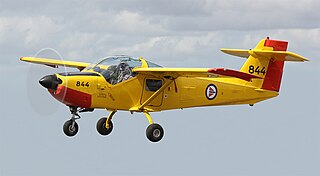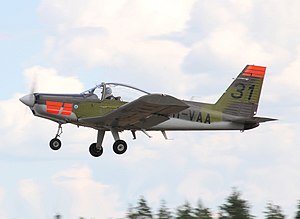
The Heinkel He 70 Blitz ("lightning") was a German mail plane and fast passenger monoplane aircraft of the 1930s designed by Heinkel Flugzeugwerke, which was later used as a bomber and for aerial reconnaissance. It had a brief commercial career before it was replaced by larger types. The He 70 had set eight world speed records by the beginning of 1933.

The British Aerospace Jetstream 41 is a turboprop-powered feederliner and regional airliner, designed by British Aerospace as a stretched version of the popular Jetstream 31. Intended to compete directly with 30-seat aircraft like the Embraer Brasilia, Dornier 328 and Saab 340, the new design eventually accommodated 29 passengers in a two-by-one arrangement like the Jetstream 31. Eastern Airways of the UK is the biggest operator of Jetstream 41s in the world, with 14 in the fleet.

The Scottish Aviation Bulldog is a British two-seat side-by-side training aircraft designed by Beagle Aircraft as the B.125 Bulldog.

The Valmet L-90 Redigo is a turboprop-powered military basic trainer aircraft and liaison aircraft, a development of Valmet's earlier training aircraft for the Finnish Air Force. The L-90 was the last military aircraft designed and produced in Finland.

The Ayres Thrush, formerly the Snow S-2, Aero Commander Ag Commander, and Rockwell Thrush Commander, is an American agricultural aircraft produced by Ayres Corporation and more recently by Thrush Aircraft. It is one of the most successful and long-lived agricultural application aircraft types in the world, with almost 2,000 sold since the first example flew 67 years ago. Typical of agricultural aircraft, it is a single-seat monoplane of conventional taildragger configuration. Originally powered by a radial piston engine, most examples produced since the 1980s have been turboprop-powered.

The IA-63 Pampa is an advanced jet trainer with combat capability, produced in Argentina by Fabrica Militar de Aviones (FMA) with assistance from Dornier of Germany.

The PZL 130 Orlik is a Polish turboprop, single engine, two seat trainer aircraft.

The Reims-Cessna F406 Caravan II is a turboprop twin engine utility aircraft manufactured and designed by Reims Aviation in cooperation with Cessna.

The Socata TB 30 Epsilon is a light military trainer aircraft produced by SOCATA. It is a tandem two-seater with a metal airframe. The first prototype flew on 22 December 1979.

The Valmet Tuuli was a trainer aircraft, developed for the Finnish Air Force by the State Aircraft Factory. The aircraft was to be produced in 3 different versions. The last version, Tuuli III was redesigned from scratch, and is basically an entirely different aircraft.

Saab MFI-15 Safari, also known as the Saab MFI-17 Supporter, is a propeller-powered basic trainer aircraft used by several air forces.
Valmet L-80 TP Turbo-Vinha was a prototype for a new Finnish turboprop basic trainer aircraft. The aircraft, which carried the designation OH-VBB, first flew on 12 February 1985. It was destroyed in a crash on 24 April 1985, during its 14th flight, killing the test pilot Paavo Janhunen. The aircraft was a further development of the Valmet L-70 Vinka and would eventually lead to the Valmet L-90 Redigo.

The Aerotec A-122 Uirapuru was a Brazilian military trainer aircraft. It was a low-wing monoplane with tricycle undercarriage that accommodated the pilot and instructor side-by-side. It first flew on 2 June 1965.

The Piaggio P.166 is an Italian twin-engine pusher-type utility aircraft developed by Piaggio Aero. The aircraft model name was Portofino, and is also known as Albatross in South African military service.

The Mudry CAP 10 is a two-seat training aerobatic aircraft first built in 1970 and still in production in 2007. The plane was developed from the Piel Super Emeraude and was born as the CP100. The name changed to CAP 10, CAP for 'Constructions Aéronautiques Parisiennes'. The CAP 10 was manufactured by Mudry in Bernay, France, bought by CAP Industries which then became Apex Aircraft. Following the bankruptcy of Apex in 2008, rights to produce spares were awarded to Dyn'Aviation. After the bankruptcy of DynAero in 2012, manufacture of spares was taken over by CEAPR in Darois.
The AAC Wamira was a turboprop military trainer aircraft, designed for the Royal Australian Air Force (RAAF) by the Australian Aircraft Consortium (AAC). The project was cancelled shortly before the first prototype was completed.
The Mooney 301 was a prototype aircraft created by American manufacturer Mooney Aircraft Company in 1983. It was a low-wing, single-engine, six-place monoplane with retractable landing gear and a pressurized fuselage.

The RTAF-5 was a Thai training and forward air control aircraft developed and built by the Science and Weapon Systems Development Centre of the Royal Thai Air Force in the 1980s. It was a twin-boom configuration aircraft powered by a single pusher turboprop engine, but only a single example was built.
The Mooney TX-1 or Mooney MT-20 was a prototype American military basic training aircraft of the 1980s. It was a two-seat derivative of Mooney's popular M20 light aircraft, but was unsuccessful, only a single example being built.

The Calidus B-250 is a tandem-seat, turboprop, light attack aircraft with counter-insurgency capability. Its structure is constructed entirely of carbon fiber, thus making it much lighter than its competitors. It has 7 hard points for placing weapons as well as EO/IR. It has Pro Line Fusion II avionics systems supplied by the American company Rockwell Collins.

















